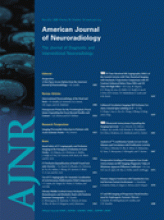Abstract
BACKGROUND AND PURPOSE: There have been inconsistencies on the prognosis and controversies as to the proper management of acute basilar artery dissection. The aim of this study was to evaluate acute basilar artery dissection and its outcome after management.
MATERIALS AND METHODS: A total of 21 patients (mean age, 53 years; range, 24–78 years) with acute basilar artery dissection were identified between January 2001 and October 2007. Clinical presentation, management, and outcomes were retrospectively evaluated.
RESULTS: The patients presented with subarachnoid hemorrhage (n = 10), brain stem ischemia (n = 10), or stem compression sign (n = 1). Ruptured basilar artery dissections were treated by stent placement with coiling (n = 4), single stent placement (n = 3), or conservatively (n = 3). Of the patients treated with endovascular technique, 6 had favorable outcome (modified Rankin scale [mRS], 0–2) and the remaining patient, who was treated by single stent placement, died from rebleeding. All 3 conservatively managed patients experienced rebleeding, of whom 2 died and the other was moderately disabled. Unruptured basilar artery dissections were treated conservatively (n = 7) or by stent placement (n = 4). Of the patients with unruptured basilar artery dissection, 9 had favorable outcome and the remaining 2 patients, both of whom were conservatively managed, had poor outcome because of infarct progression. The group with the ruptured basilar artery dissection revealed a higher mortality rate than the group with the unruptured dissection (30% vs 0%). The group treated with endovascular means revealed more favorable outcome than the group that was treated with conservative measures (90.9% vs 50%).
CONCLUSION: The ruptured basilar artery dissections were at high risk for rebleeding, resulting in a grave outcome. Stent placement with or without coiling may be considered to prevent rebleeding in ruptured basilar dissections and judiciously considered in unruptured dissections with signs of progressive brain stem ischemia.
- Copyright © American Society of Neuroradiology












